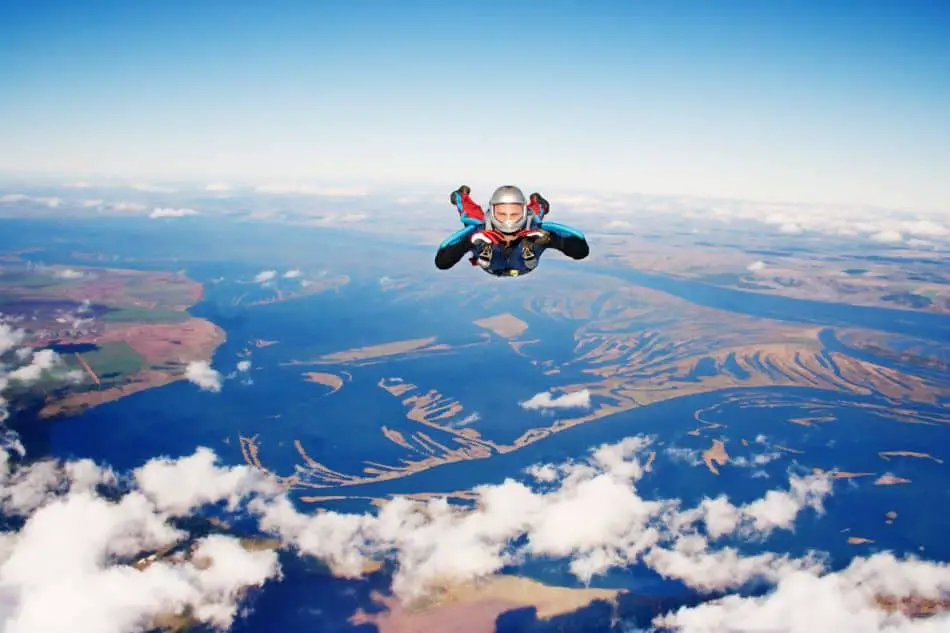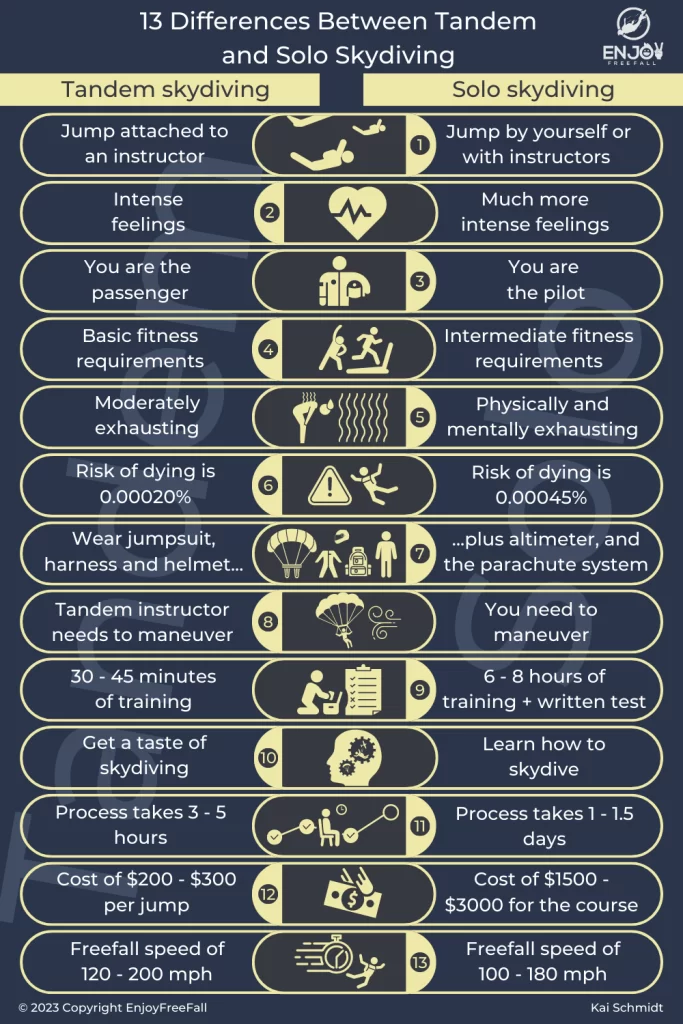
Many people decide to complete a tandem jump for their first skydive. Some people ask themselves afterward about how different solo skydiving would be. Other people even consider doing a solo jump for their first skydiving.
If you are in doubt, here are the 13 differences between tandem and solo skydiving.
- You Jump Alone When Skydiving Solo
- Your Feelings Will Be Much More Intense When Skydiving Solo
- Your Are the Pilot and Not the Passenger
- There Are Different Fitness Requirements
- It Is More Exhausting to Jump Alone
- Solo Skydiving Is Riskier Than Tandem Skydiving
- You Wear Different Gear
- It Is Easier to Maneuver Around
- You Need More Preparation for a Solo Skydive
- You Learn More During a Solo Skydive
- Solo Skydiving Takes Longer
- Solo Skydiving Is More Expensive
- Tandem Skydiving Is Faster
Jumping Alone Without Being Alone When Skydiving Solo
Many people believe that the biggest difference between skydiving solo and tandem is that you jump without an instructor when solo skydiving. While this is true for most jumps, it is not true for the first skydive.
In fact, first-time solo skydivers are often accompanied by two instructors who jump next to them and stabilize them in freefall. The instructors can intervene in case of any parachute malfunctions or other problems. When the student skydiver is able to complete this jump to the satisfaction of his instructors, the instructors will allow the student to progress to the next learning level.
The true difference between skydiving solo and tandem is, therefore, not that solo skydivers jump without instructors but that solo skydivers are not attached physically to their instructors.
When skydiving tandem, the student will hang in a harness below the tandem instructor. The tandem instructor will do all of the work and the student can just focus on enjoying the freefall and the scenery.
The Different Feelings Between Solo Skydiving and Tandem Skydiving
Tandem skydiving is often a once-in-a-lifetime experience that is quite intense for many people. And I agree: tandem skydiving is amazing. Solo skydiving, however, is 50 times more intense. It is a different level.
You are more afraid when skydiving solo. Skydiving requires courage. Not many people find their courage to do a tandem skydive – not to speak of jumping solo. If I compare my first tandem jump with my first solo skydive, I was 10 times more afraid before my first solo jump. I had already performed a tandem jump before so I knew what to expect.
However, it was easier for me to calm down before my tandem jump. After all, I was jumping with someone who had performed thousands of jumps before and nothing has happened to him. So it would be very unlikely that anything could happen on our jump.
You need to focus much more. During my tandem jump, I could also focus on calming down. I could focus on slowing down my breathing. I did not need to do anything else. Solo skydiving is different. You are in charge. You manage the skydive. You need to focus on the environment, on the altimeter, and on having the right body position. You also need to actively jump out of the airplane – which is much harder than being pushed.
Your body will release much higher doses of hormones. Once you are in freefall, it feels like your body explodes: you will be pumped with adrenaline, you will be very present in the moment. You made it, you jumped alone! It will feel surreal and real at the same time. You will feel alone and yet in company with your instructors.
The feeling of relief afterward. Once you pull the parachute at 4,000ft and it opens properly, you will feel strong relief. Nothing can beat you. You still need to continue to focus on your ride down but it will feel great. In contrast to tandem skydiving, you will steer the canopy yourself so you need to find the dropzone and fly towards it.
For both solo and tandem skydiving, you will feel a level of achievement afterward. You were brave enough to jump and fulfill a little dream. When skydiving solo, the feeling of achievement will be much higher. In the end, you managed to jump from 15,000 ft.
If you want to learn more about the true (and unexpected) feelings during skydiving and what causes sensory overload, check out my post about the 7 true feelings of skydiving.
Being the Pilot and Not the Passenger When Skydiving Solo
The best comparison between skydiving solo and tandem is that you are a passenger during the tandem skydive. You are in a quite passive role, where you do not need to do anything and can just enjoy the ride.
When you skydive solo, you are the pilot. You are in control and you need to make sure that your jump works out fine. You need to bring yourself in the right body position, you need to observe the environment for other skydivers, you need to constantly check the altimeter and you need to deploy the parachute. You also need to steer the canopy to the dropzone and land properly.
“I felt extreme awareness as if I was meditating. It felt like making love with angels. I was in the controls now, I was the one who made the decisions, I was the pilot and not passenger”
Anonymous, Found in Quora
Not only does it require skydiving solo to be more active, but it also comes with an increased level of responsibilities. You are not only responsible for yourself but also for the other skydivers around you. A mistake such as opening the parachute too early can have fatal consequences for others.
The Different Fitness Requirements Between Skydiving Solo and Tandem
While many requirements are exactly the same between solo and tandem skydiving, there is a difference concerning the necessary fitness conditions. It is often not officially stated, however, skydiving companies will pay more attention to your fitness level if you skydive solo.
And it makes sense. It is possible to skydive tandem if someone does not have the strength to stabilize oneself during freefall because the tandem instructor will stabilize himself and the student. While the two instructors who usually jump besides first-time solo skydivers can stabilize the student as well, it is often more difficult to do that. They will also not be able to assist the student during the landing.
In addition to the different fitness requirements, there are also some nuances between the size and weight of tandem and solo skydivers:
| Basic Requirements | Solo Skydiving | Tandem Skydiving |
| Minimum Age | 18 years old | 18 years old |
| Maximum Age | None | None |
| Maximum Weight | 240 lbs (109kg) | 220 lbs (100kg) |
| Minimum Height | 5′ 2″ | 5 feet |
| Maximum Height | 6’11” | 6’11” |
Skydive Alone Is More Exhausting Than Skydiving Tandem
Closely related to the different fitness requirements is that skydiving alone is physically and mentally more exhausting than skydiving tandem. Specifically, steering the canopy can be very exhausting for the arms and shoulders and is often underestimated.
Not only do you need to steer the canopy when skydiving solo, but you also need to carry around the parachute – which can be quite heavy. When skydiving tandem, your tandem instructor will carry the parachute around and will also pack it after the jump.
In addition, skydiving solo is mentally much more exhausting than skydiving tandem. When jumping tandem you do not need to do much and can just focus on enjoying the jump. However, solo skydiving puts a mental and emotional challenge on you.
While you will be energized and full of joy directly after the jump, you will feel exhausted and drained in the afternoon.
Solo Skydiving Is Riskier Than Tandem Skydiving
Many people think that solo skydiving is safer because the parachute carries less weight and people are not attached to each other. However, quite the opposite holds true.
During a tandem skydive, the tandem instructor will take care of everything. As tandem instructors are less likely to make any mistakes, tandem skydiving is much safer. Tandem instructors also need to perform at least 500 jumps and need to undergo special safety training in order to get their tandem license.
If you want to learn more about the requirements for tandem instructors, check out my guide about it! It will demystify the job of tandem instructors and will make you feel much safer during your next tandem jump!
Statistically speaking, tandem skydiving is 2.5 times safer than solo skydiving. That being said, skydiving solo is also extremely safe with only one fatality in every 220,301 jumps. This means that you are more likely to be hit by a meteorite than to die from a skydive.
You Wear Different Gear When Skydiving Solo
Another major difference between skydiving solo and tandem is the equipment. Tandem parachutes are much bigger than solo parachutes because they need to carry more weight. Their increased size makes it harder for the tandem instructor to steer the canopy and to maneuver around in the air. It will also be much heavier when carrying it around on the ground.
In addition, tandem skydiving involves different harnesses and different systems with which the student is attached to the tandem instructor. The attachment mechanism is designed to be extremely robust and often has a retention force above 2 tons.
When skydiving solo you do not need such a system and you directly wear the parachute on your back.

It Is Easier to Maneuver Around When Skydiving Solo
Solo skydivers are much more maneuverable than tandem skydivers. As you can imagine tandem skydivers are much bulkier than solo skydivers and therefore move slower. The tandem instructor also needs to counterbalance the movements of students in order to stabilize the belly-to-earth position.
Even if two experienced tandem skydivers were to jump together, it would still be harder for them to maneuver quickly in the air and it would require much more coordination.
For solo skydivers, in contrast, each body movement translates into a movement during free fall. It is also much easier to track through the air or to perform flips.
The supreme discipline of this is formation jumps where skydivers build an illustration of a motive in the air. However, it is only possible to take part in formation jumps after having performed many jumps and being quite experienced in the air.
Stunts like formations not only look cool but are also difficult to perform, given the limited freefall time. In a stunt, every movement has to be near perfect, otherwise, skydivers might miss the right height for parachute deployment. Learn more about how long the freefall time for skydivers is and the surprising ways to manipulate it, check out my article about it.
Skydiving Tandem Does Not Require Much Preparation
One of the best sides of tandem skydiving is that it does not require any preparation. First-timers just need to make an appointment with their skydiving company and they are ready to go. On the ground, first-timers will take part in a quick briefing about what to do and not to do in the air. Afterward, they can jump.
Solo skydiving, in contrast, requires intensive ground practice and theory lessons beforehand. New skydivers need to learn basic things about the equipment, how to pack parachutes, and the safety rules in and outside the airplane. In addition, beginners need to know how to exit the aircraft, how to get in the right body position during freefall, and how to deploy the parachute.
Once the parachute is deployed, the beginner also needs to know how he steers the canopy to the dropzone and how he lands safely. Learning all this requires some time and as a result, most skydiving companies will only allow beginners to solo skydive after they have internalized these things.
Are you currently thinking about doing your first tandem jump? If yes, it will help you to know in detail how tandem skydiving works. My article about tandem skydiving is ideal for skydiving newcomers who will conduct their first jump soon. It covers all safety aspects and provides practical tips to make your jump as enjoyable and memorable as possible!
You Learn More During a Solo Skydive Than During a Tandem Skydive
The advantage of this preparation is that you will learn much more when skydiving solo. Not only do you learn more about the skydiving sport itself, but also you learn more about yourself. As already explained, it is much more challenging to skydive solo than to perform a tandem jump.
Managing and overcoming one’s fear is key in skydiving. Everyone handles this challenge differently and getting to know your process will help you in other areas of life as well. Tandem skydiving also requires a lot of courage, however, it is often not as intense as solo skydiving.
Some people are extremely scared of heights. For them, tandem skydiving can be a great first step to learn how to manage their fears. Skydiving is also known as a therapy for people with acrophobia (the extreme or irrational fear of heights).
Would you like to know how skydiving boosts your confidence and helps you channel your fear into something thrilling? Here’s my post about it where I talk about the 7 reasons to skydive when being scared of heights.
Solo Skydiving Takes Longer Than Tandem Skydiving
Depending on whether you go on the weekend or during the week, tandem skydiving usually takes between 3 – 5 hours. This time also includes 20 minutes of ground training and instructions by the skydiving company before the tandem jump.
As aforementioned, skydiving solo requires you to book a skydiving course. One of the most common ways to learn skydiving is through an “Accelerated Free Fall” (AFF) course. The first day of an AFF course normally includes extensive theory lessons and a tandem jump.
Most skydiving companies will not allow you to jump solo without completing the first day of this course. As a result, skydiving solo as a beginner takes you at least 1 – 1.5 days.
If you want to know more about the timeline of tandem skydiving, check out this post.
Solo Skydiving Is More Expensive Than Tandem Skydiving
Because you often need to book a course in order to skydive solo, it is much more expensive than skydiving tandem An AFF course costs between $2,200 – 2,900 while tandem skydiving usually only costs around $200 – 350 depending on whether you add video footage to your package.
A good way to pay less for a solo skydive is to enroll in trial courses. Trial courses only cost between $500 – 700 and replace the first steps of a full skydiving license course. You will learn the relevant theory and you will do the necessary ground exercises to complete your first solo jump.
If you decide afterward that you want to continue skydiving and get your full license, the trial course price will be deducted from the full AFF course price.
If you are already thinking about picking skydiving up as a hobby, I have written another article about the 9 reasons why you should pick skydiving up as a hobby here.
Tandem Skydiving Is Faster Than Solo Jumps
The last difference between tandem and solo skydiving is that tandem skydiving is usually much faster. Because two people are attached to each other, they will weigh more and hence will fall faster.
If tandem skydivers fall in a belly-to-earth position, they will reach their terminal velocity at around 120 mph. However, they can even go as fast as 200 mph when they fall in a head-down position.
Solo skydivers can only reach a similar speed but only if they jump from much higher altitudes and add weights to their equipment. The normal speed for solo skydivers is between 100 – 180 mph depending on their weight and their body position.
In my personal opinion, I would always go for a tandem jump first. If you enjoy the tandem jump, chances are high that you will also enjoy solo skydiving.
If you are not even sure, if you want to try a tandem skydive, I have written an article about the 11 reasons to go tandem skydiving. You can read it here.
That being said, enjoy your freefall!



